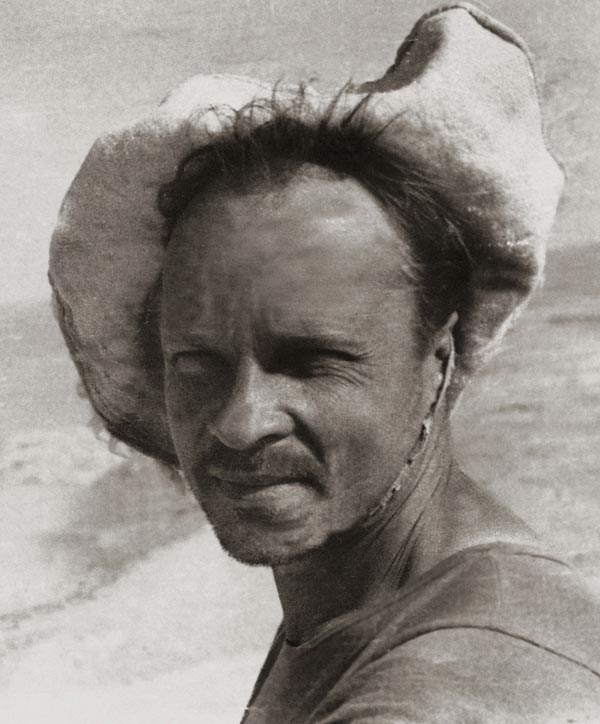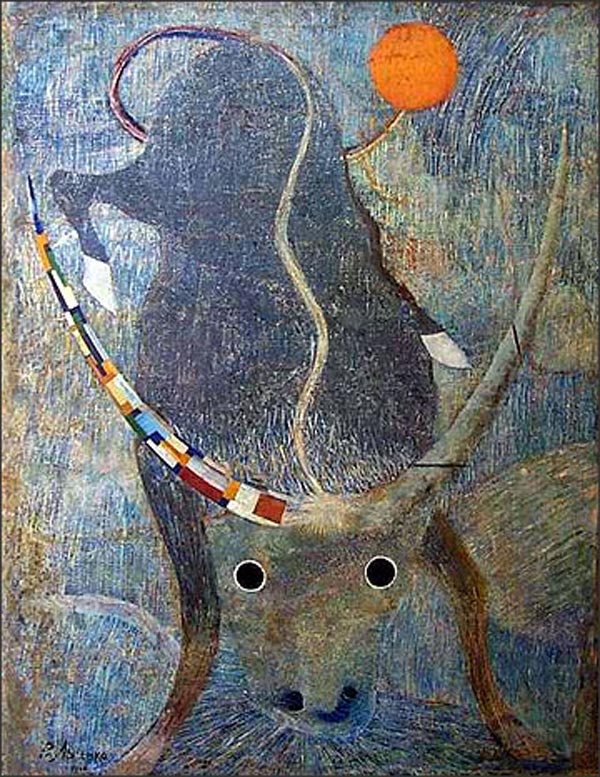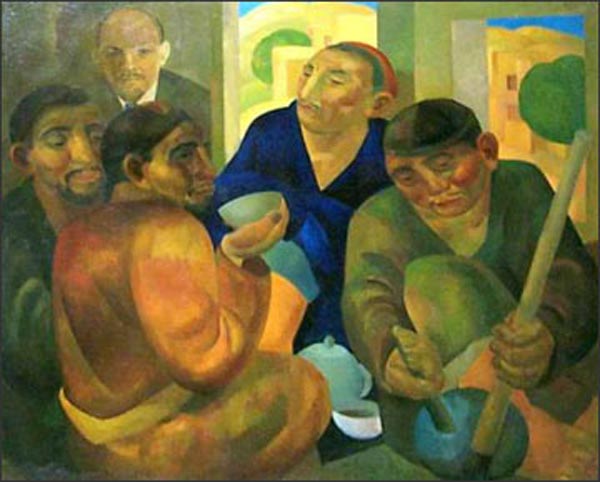- Нас покидают...
- Guide to photo reports from exhibitions
- Икона “Господь Вседержитель”, серебро, эмаль.
- Икона “Господь Вседержитель” , оклад,эмаль.
- ASSESSMENT ON Internet (Information database for 5000 artists)
- Still Life Flowers Eugene Lang
- Автопортрет художника. 1930-е.г. Атрибуция.
- Положение во гроб Иисуса Христа оценка
- Bronze. E.Lancere.
- collages on the theme of the war in Ukraine
Interviews with the authors of the film "Desert forbidden art"
ARTinvestment.RU 14 марта 2011
Details about the second-largest collection of the Russian avant-garde in the world

Igor Savitsky
Source:

Evgeny Lysenko
Bull (Fascism comes).
Source:

Alexander Volkov
Teahouse.
Source:
over the weekend in New York's Cinema Village theater last year showed film "Desert forbidden art", which tells about the collection of Igor V. Savitsky (1915-1984), the first director of the Museum of Arts Uzbek city of Nukus. Website advantage of this opportunity to interview the creators of tape - Chavdar Georgiev and Amanda Pope (Amanda Pope). ARTinvestment.RU offers a translation of this interesting material.
ARTINFO: Chavdar, you grew up in the USSR. Did you know about the museum in Nukus?
Chavdar Georgiev : I not only had not heard about such a collection, but even the existence of the Nukus no idea. It was a closed city, where produce chemical and biological weapons. About him very little people know about. In Russia, the city of Nukus and Savitsky collection known except that the leading art historians and those who, so to speak professionally connected with the activities of the city.
Amanda Pope : In Washington, for example, building the CIA, too, is not publicized. And then the city where developing chemical weapons. Of course, the Soviet authorities did not want him to someone he knew.
C. G. : And with this in Nukus is the second largest collection of Russian avant-garde art - more than 40,000 paintings and drawings.
ARTINFO: Tell us about the collection in detail. As Igor Savitsky generally managed to collect so much art in times of censorship?
C. G. : He was a crafty, as told to Amanda. A very charming man, absolutely devoted to his hobby. He literally lived in the museum. He's got hung on a hanger one suit, made specifically for the visits of the authorities. When it had come, he put on this costume. He did everything in the museum itself. And when the local office of the Communist Party gave him an apartment, he immediately gave her two conservators from Moscow, who had nowhere to live.
AP : Do Savitsky had no money, but he moved in artistic circles, and walked from one widow to another. His collection of 1920-30's going for almost two decades - since the second half of 1960 until his death in 1984. So, he went to look at the pictures, asked the widows to deploy them - they saw that he really loves art, that he is a true connoisseur. And they wanted their husbands' work on display at the museum. What we are really touched when we were working on the film - so this is how deep into the Russian people who laid the love for art. They are not interested in the auction value of work - it is important that the picture came to the museum to see its people.
ARTINFO: What are the outstanding works boasts a collection of Savitzky?
C. G. : There is absolutely stunning works of artists from Moscow and St. Petersburg, but the real gems - a product of the so-called "Oriental Avant-garde" artists, who came from Moscow, from Petersburg, even from Siberia - to build a new society in Central Asia. And Central Asia was for them as Tahiti for Gauguin: luxurious colors, Islam, Sufism, the Silk Road ... In their work the influence of Islam united with European modernism and the Russian avant-garde. And so came this startling new movement in art that have not seen anywhere except in Uzbekistan.
AP : The artists are portrayed camels in the desert - but the camels in the cubist style. Interesting, unique style. We hope that the Uzbek government can be persuaded to really "recognize" this collection and make some efforts to promote it - now she can say is hidden from everyone - and that Nukus works will be exhibited, so that you can show them in other museums. This can be easily arranged, if the government is ready to cooperate.
ARTINFO: As far as I know, the director of the museum (Marinika Babanazarova. - AI.) Already approached some western art dealers with offers to sell works from the collection. Was not she tempted to put some items in the market to the money to take care of the rest of the meeting?
AP : As for the temptation - I do not think, but the proposals were of course. Another thing is that the Art Museum in Nukus - the state, and she can simply order to sell a particular exhibit.
C. G. : If tomorrow comes daughter of the president and say, "Oh, what a beautiful decoration!", then what can you do?
ARTINFO: Do you have favorite pieces in the collection Savitsky?
AP : Yes. "Purple road» Ural Tansykbaev .
C. G. : I have two favorite paintings. The first - a "bull" of the painter Eugene Lysenko, also known as "Fascism is coming." The image of a bull with a rifle barrels instead of the eyes had seen him in a dream. Work can be seen only in the Nukus Museum. The artist called it "fascism comes, as it is being - is written in the expressionist, avant-garde style - looks truly frightening. This work was prophetic: after a while broke Stalin's repressions. A second favorite painting, titled "Teahouse" was performed Alexander Volkov , a Russian artist, born in Uzbekistan . It is curious that we have not seen it on the wall of the museum and in storage. That's an incredible painting of Uzbeks over tea. True, they drink tea in the background of a portrait of Lenin - the work was created in Soviet times, and without Lenin, of course, was not enough. As we now have in America without Obama. A picture of Lenin, now in Uzbekistan is not in favor, so the work is mired in the store and visitors to admire it can not. It can only be seen in the film.
AP : This is the thing at an early Picasso. Absolutely amazing picture. And the fact that she is now in the store just because of a portrait of Lenin on the wall ...
ARTINFO: Art is still very much depends on the policy.
AP: Yes, they are still "tied". Life Savitsky, the collecting of his activities - everywhere policy played a central role. And now the same situation.
P. S. Nukus museum has experienced an extremely unfriendly to the artistic vanguard of the Soviet era, but now his fate is unclear. Recently, the Director Marinika Babanazarova not even released from the country to film in the Washington National Gallery.
Interview: Kate Daymlin (Kate Deimling), ARTINFO.com
Translation Julia Maksimova, AI
Source: , artinvestment.ru
.
.
.
https://artinvestment.ru/en/news/artnews/20110314__interview_nukus.html
https://artinvestment.ru/news/artnews/20110314__interview_nukus.html
When quoting reference to the https://artinvestment.ru without fail
Attention! All materials of the site and database of auction results ARTinvestment.RU, including illustrated reference information about the works sold at auctions, are intended for use exclusively for informational, scientific, educational and cultural purposes in accordance with Art. 1274 of the Civil Code. Use for commercial purposes or in violation of the rules established by the Civil Code of the Russian Federation is not allowed. ARTinvestment.RU is not responsible for the content of materials submitted by third parties. In case of violation of the rights of third parties, the site administration reserves the right to remove them from the site and from the database on the basis of an application from an authorized body.
- 16.08.2022 Расследование ФБР подрывает репутацию Художественного музея Орландо Отменены три выставки, из собрания отозваны отдельные работы
- 14.08.2020 Face mask for $1.5 million In this sum cost the unnamed "billionaire from Shanghai" ordering a mask of gold and diamonds from the jewelry company Yvel
- 14.08.2020 A special contract for buyers of art of authors of African descent For fight against speculators, Christie's has developed a list of conditions of purchase
- 13.08.2020 Cultural institution in the U.S. last year spent $7.9 billion This year a repeat result is not obtained – loss of art-индустрии the United States already amounted to $150 billion And this is not the final figure
- 13.08.2020 Biography Yayoi Kusama will be released as a graphic novel With the history of one of the most successful contemporary artists in the form of a comic book will be available from 15 September 2020
- 03.08.2018 Торги «Антиквариума» 28 июля. Краткие итоги Наторговали на 3,6 миллиона рублей — 131 % от эстимейта. Одним из топ-лотов стала работа Владимира Немухина, проданная за 240 тысяч
- 25.07.2018 Очередной аукцион #всёпорублю в «Литфонде» принес почти 4,5 млн.руб. Топ-лотом стала икона «Богоматерь Владимирская» — 600 тыс. руб.
- 24.07.2018 «Русская Эмаль» торжественно закрывает сезон и уходит в отпуск На завершающих торгах 14 июля «Русская эмаль» порадовала участников Кандинским, целой коллекцией нэцкэ и произведениями Пыжовой
- 16.07.2018 Краткие итоги сороковых живописных торгов «Кабинета» Аукционный дом «Кабинет» проводит последние торги сезона и уходит в отпуск до осени, вслед за своими игроками
- 03.07.2018 Коротко о главном: итоги аукциона 28 июня в «Литфонде» Рейтинг возглавляют классики русской литературы, а сказочники продолжают удивлять
- 12.08.2020 Literature: Piroska Dossey. Sold! The book is about the phenomenon of pricing, the original title of which was ahead of its time in a decade
- 07.08.2020 Movies: "the Cool school" The emergence of abstract expressionism on the West coast of the United States the voice of the Big Lebowski
- 06.08.2020 Cross-trades in the summer of 2020. ArtTactic Report Analysis of auction sales of a new format with the participation of the old masters
- 04.08.2020 Opened 27-й auction "twenty-first century. Contemporary Russian art" The catalogue contains artworks of Seeds Agroskin, Alexei Vaulin, Dima Goryachkin, Dasha Delone, Anna Laurel, Denis Mikhailov, Andrei Munz, Arman Sirunian, Kathy-Анны Taguchi and Tatiana Yang
- 31.07.2020 10 most unusual ArtTech-стартапов 2020. Part 1 AI talks about young companies whose ideas have become especially popular with the onset of the quarantine
- 07.03.2023 Неизвестный известный Серж Иванов (1893–1983) История происхождения ранних картин С.П.Иванова
- 17.06.2022 Выставка Люси Вороновой в галерее Atelier CHOUTKO На выставке будут представлены живописные произведения Вороновой разных лет и состоится премьера ковра ручной работы, созданного художницей совместно с Atelier CHOUTKO
- 14.03.2022 Эрмитаж потребовал досрочно вернуть работы, участвующие в итальянских выставках В Россию в ближайшее время вернутся около 25 картин
- 30.07.2020 In Saint-Петербурге opened the exhibition "Artists and collectors — to the Russian Museum. Gifts. 1898-2019. Favorites" The exhibition, held simultaneously on all the main belt, has collected more than 1,500 items donated to the Museum since the founding of the
- 27.07.2020 Fedor Rokotov exhibition opens at Historical Museum of Moscow A collection of works of the famous Russian portrait painter XVIII veka will showcase on 29 July 2020
Top 34
- 1. Alberto Giacometti$141,7 million
- 2. Damien Hirst$100 million
- 3. Constantin Brâncuși$71 million
- 4. Amedeo Modigliani$70,7 million
- 5. Jeff Koons$58,4 million
- 6. Unknown artist$57.2 million
- 7. Henri Matisse$48,8 million
- 8. Paul Gauguin$30,96 million
- 9. Henry Moore$30,1 million
- 10. Willem de Kooning$29,28 million
- 11. Pablo Picasso$29,2 million
- 12. Unknown artist$28,6 million
- 13. Louise Bourgeois$28.16 million
- 14. Adrian de Vries$27,9 million
- 15. Alexander Calder$25,9 million
- 16. Unknown artist$23,826 million
- 17. David Smith$23,816 million
- 18. Yves Klein$22 million
- 19. Auguste Rodin$20,41 million
- 20. Unknown artist$19,1 million
- 21. Edgar Degas$18,82 million
- 22. Maurizio Cattelan$17,19 million
- 23. Unknown artist$16,88 million
- 24. Takashi Murakami$15,16 million
- 25. Donald Judd$14,16 million
- 26. Unknown artist$11,64 million
- 27. Antonio Canova$11,5 million
- 28. Bruce Nauman$9,9 million
- 29. Aristide Maillol$8,32 million
- 30. Unknown artist$8,146 million
- 31. Cy Twombly$7,7 million
- 32. Julio Gonzalez$7,45 million
- 33. Marino Marini$7,15 million
- 34. Urs Fischer$6,8 million
- Нас покидают...
- Guide to photo reports from exhibitions
- Икона “Господь Вседержитель”, серебро, эмаль.
- Икона “Господь Вседержитель” , оклад,эмаль.
- ASSESSMENT ON Internet (Information database for 5000 artists)
- Still Life Flowers Eugene Lang
- Автопортрет художника. 1930-е.г. Атрибуция.
- Положение во гроб Иисуса Христа оценка
- Bronze. E.Lancere.
- collages on the theme of the war in Ukraine